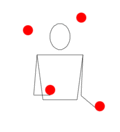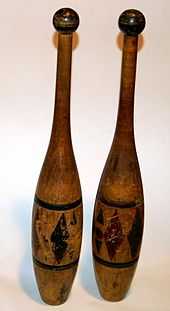Fountain (juggling)
 | |
| Minimum prop #: 4 | |
| Difficulty: 7/10[1] (note: difficulty ratings are arbitrary and subject to change) | |
| Siteswap: 4 |
_ladder_diagram.png)
(4)_ladder_diagram.png)
The fountain is a juggling pattern that is the method most often used for juggling an even number of objects. In a fountain, each hand juggles separately, and the objects are not thrown between the hands. To illustrate this, it can be seen that in the most common fountain pattern where four balls are juggled, each hand juggles two balls independently. As Crego states "In the fountain pattern, each hand throws balls straight up into the air and each ball is caught in the same hand that throws it."[2]
A fountain can be synchronous or asynchronous. In a synchronous fountain, both hands throw at the same time, while in an asynchronous fountain, the hands alternate throws. The fountain is juggled in either a circular fashion or in columns. The circular method means that the balls juggled travel in a circle like motion with the jugglers hands throwing the ball from a point close to their body centre line and catching the ball further away from their body centre line. This circle motion is called 'outside circles' and is the fountain pattern shown in the animation. This circle method can be reversed to create an 'inside circle' pattern whereby throws are from a position away from the body midline and catches are closer to the body midline. In the columns method the balls all travel vertically up and down in their own 'column', and are caught from where they are thrown.
The fountain is used for juggling even numbers of objects because other patterns which alternate between hands, such as the cascade, do not work well for even numbers of objects.
Other fountain patterns
Wimpy is a juggling pattern resembling a two handed synchronous fountain.
References
External links
- IJDb: Fountain at the Wayback Machine (archived December 14, 2007)
| ||||||||||||||||||||||||
